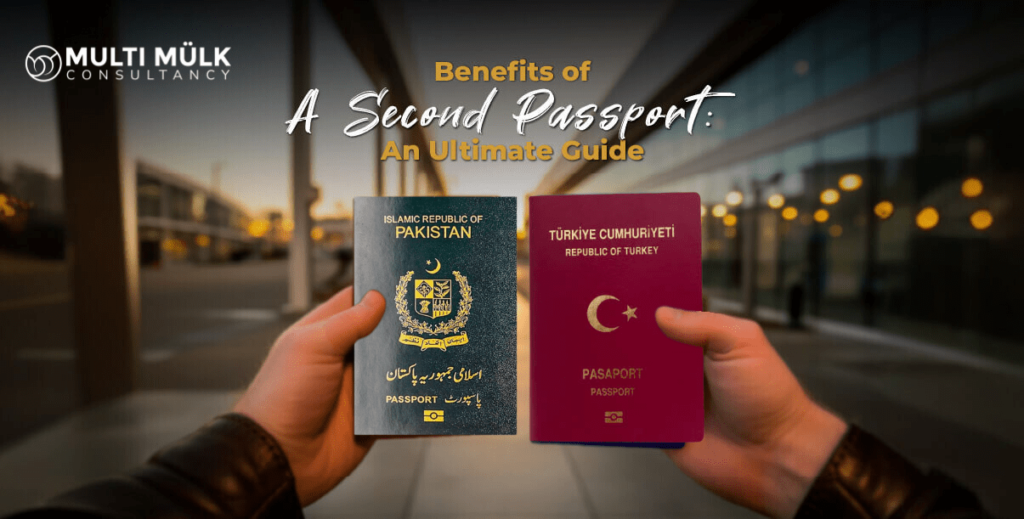In today’s globalized world, obtaining a second passport can be a valuable asset, offering greater freedom, security, and access to new opportunities. A second passport allows for easier international travel, better financial planning, and, in some cases, a higher quality of life. This guide will explore the primary pathways to securing a second passport, including citizenship by investment (CBI), naturalization, and ancestral citizenship. Each route has its unique benefits and requirements, which we will examine in detail.

1. Citizenship by Investment (CBI)
Citizenship by Investment (CBI) programs are designed for individuals who can make significant financial contributions to a country’s economy. These programs offer a relatively fast track to citizenship, typically through investments in real estate, government bonds, or contributions to a national development fund.
Benefits of CBI:
- Expedited Process: CBI programs often have a streamlined application process, with approvals sometimes granted within a few months.
- Global Mobility: Countries offering CBI programs frequently provide visa-free or visa-on-arrival access to numerous countries, enhancing travel freedom and convenience.
- Investment Potential: Investments in real estate or business ventures can yield substantial returns, making CBI programs appealing to investors.
Examples of CBI Programs:
- Turkey: The Turkish CBI program allows individuals to gain citizenship by investing at least $400,000 in real estate. This program is particularly attractive due to Turkey’s strategic location and growing economy. The country offers visa-free travel to over 110 destinations, including Japan and Singapore, making it a favorable choice for global mobility.
For more information on the Turkish CBI program Click Here
- Malta: Malta offers a CBI program through investment in government bonds, real estate, or a national development fund. The program provides access to the EU and Schengen Area, making it highly desirable for those seeking European mobility.
2. Naturalization
Naturalization is the process of acquiring citizenship after meeting specific residency and legal requirements in a country. This pathway is ideal for individuals who have lived in a country for an extended period and wish to integrate fully into its society.
Requirements for Naturalization:
- Residency Period: Most countries require a period of legal residency, often ranging from five to ten years. This period can vary based on the country’s policies and the applicant’s circumstances.
- Language Proficiency: Applicants may need to demonstrate proficiency in the host country’s language, which can involve passing a language test.
- Cultural Integration: Some countries require applicants to pass a citizenship test that assesses their knowledge of the country’s history, culture, and legal system.
Example of Naturalization Process:
- Spain: In Spain, non-EU residents can apply for citizenship after ten years of legal residency. The process includes a language test and a cultural knowledge test, ensuring that applicants are well-integrated into Spanish society. The Spanish passport offers visa-free access to a wide range of countries, making it an attractive option for global citizens.
3. Ancestral Citizenship
Ancestral citizenship, also known as citizenship by descent, allows individuals to claim citizenship based on their ancestry. If you have parents, grandparents, or even great-grandparents from a particular country, you may be eligible for citizenship in that country.
Benefits of Ancestral Citizenship:
- No Residency Requirement: Unlike naturalization, ancestral citizenship typically does not require a period of residency in the country.
- Cultural Connection: This pathway can provide a meaningful connection to one’s heritage and cultural roots.
- Simpler Application Process: The process for obtaining ancestral citizenship is often less complex and more straightforward than other methods.
Example of Ancestral Citizenship:
- Ireland: Ireland offers citizenship to individuals with at least one Irish grandparent. This provision has made Irish citizenship accessible to many people of Irish descent living abroad, particularly in the United States and Canada. The Irish passport provides visa-free access to numerous countries, including those in the EU and Schengen Area.
4. Key Considerations and Steps
Before pursuing a second passport, it is essential to consider several factors and steps to ensure a smooth application process.
Legal Implications: Understand the legal implications of holding dual citizenship. Some countries do not permit dual citizenship, which may require you to renounce your original citizenship. It is crucial to consult with legal experts to navigate these complexities.
Financial Requirements: Be aware of the costs associated with obtaining a second passport, including application fees, investments, and legal expenses. Some CBI programs require significant financial outlays, so it’s important to budget accordingly.
Personal and Professional Goals: Consider how a second passport aligns with your long-term personal and professional goals. Whether it’s for increased travel flexibility, better tax planning, or securing a safe haven, ensure that your choice aligns with your objectives.
Steps to Secure a Second Passport:
- Research: Begin by researching the countries and programs that best suit your needs and circumstances.
- Consult Experts: Engage with immigration lawyers and financial advisors specializing in citizenship matters. They can provide valuable guidance and ensure that you meet all legal and financial requirements.
- Prepare Documentation: Gather all necessary documents, such as birth certificates, proof of ancestry, financial statements, and any other required paperwork.
- Submit Application: Follow the specific application process for the chosen program or country, ensuring all forms are completed accurately and submitted on time.
- Monitor Application Status: Stay informed about the status of your application and be prepared to provide additional information if requested by the authorities.
Securing a second passport can be a transformative step, offering access to new opportunities and increased security. Whether through investment, naturalization, or ancestral ties, the journey to obtaining a second passport requires careful planning and consideration. By understanding the various pathways and their benefits, you can make an informed decision that aligns with your personal and professional goals
